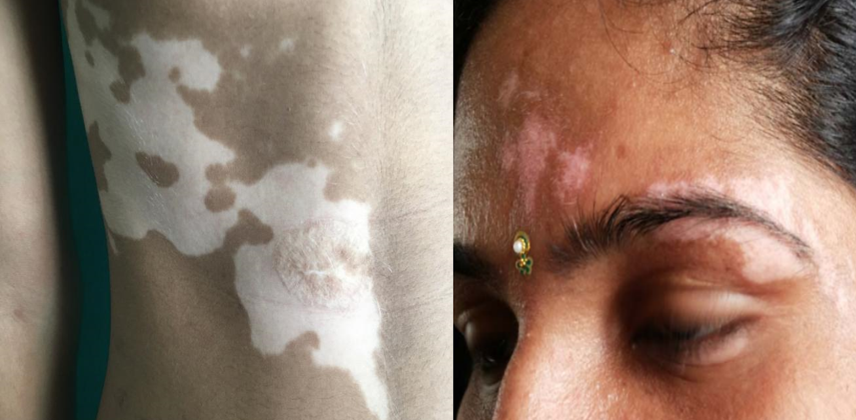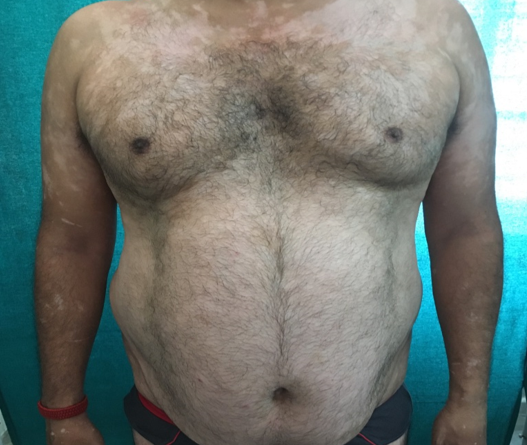Introduction
Vitiligo is an acquired disorder of the skin and mucous membranes that is characterized by well circumscribed macules and patches and that occurs secondarily to selective destruction of melanocytes. 1 The prevalence of vitiligo ranges from 0.5% to 1%.2 Its highest incidence has been reported amongst Indians from the Indian subcontinent. India is considered to have the highest prevalence in the world, at about 8.8%. 2 Mexico and Japan also has high prevalence of vitiligo.2 A small prevalence has also been reported by many studies in India, China and Denmark have reported the prevalence to be 0.093%, 0.005% and 0.38% respectively.
The family history has been found to affect the prevalence of Vitiligo amongst such people prevalence is high ranging from 7.7% to more than 50%. The mean age of onset is also earlier in those with a positive family.3
The gender-wise distribution of the disease is equal affecting adults and children of both sexes are equally. However, more females were reported to have this condition. It may due to the higher social impact posed by this condition on women and girls. In nearly 50% of the patients Vitiligo developed before the age of 20 years and in almost 70-80% patients before the age of 30.3 Most of the vitiligo cases reported beginning of disease during the period of active growth.
The etiopathogenesis of Vitiligo is complex, multifactorial and largely unknown. Several theories have been proposed explaining the role of oxidative stress, autoimmune factors, neurohumoral, and autocytotoxic factors.4 The different factors have been contributing towards the occurrence of the disease and none of the theory is mutually exclusive. This study was carried out with an objective to document clinico-epidemiological features of vitiligo from this part of the country having varied geo-climatic conditions, rural and semi-urban communities of diverse ethnic backgrounds and living styles differing from rest of the places.
Materials and Methods
Total forty (40) patients with clinically diagnosed vitiligo were chosen for observational study in tertiary care hospital and written consent was taken to participate during the study period of 1 year. A detailed history of onset, duration, progression and associated symptoms were obtained from the patients and their parents. Relevant past history, family history and drug intake prior the onset of the disease is recorded. General and systemic examination was done.
Dermatological examination was carried out. Morphology, distribution, progression and various special features were recorded. Oral and genital mucosa were examined. The results was analysed and discussed in detail.
Results
A total of 40 patients were included in the study. Among these 20 were female and 20 were male. The female to male ratio was 1:1 [Table 1]. The age at onset was found to be in the 2nd decade of life in 14 patients, while majority of patients belonged to the age group between 21 and 30 years - 251 (24.8%) [Table 1]. Mean duration of disease presentation was 1-5 years 559 (55.5%) [Table 2].
Table 1
Distribution of age & sex among vitiligo
|
Age (Years) |
Female |
Male |
|
21-30 |
7 |
7 |
|
31-40 |
6 |
6 |
|
41-50 |
3 |
4 |
|
>50 |
4 |
3 |
|
Total |
20 |
20 |
Table 2
Distribution of vitiligo according to duration of disease
|
Duration of Vitiligo (in Years) |
Number of Vitiligo N=40 |
|
<1 |
1 |
|
1- 5 |
17 |
|
6 - 10 |
15 |
|
>10 |
7 |
Majority of Vitiligo cases in our studies have duration of disease in between 1-5 years.
Table 3
Distribution of number of vitiligo cases according to type of vitiligo
|
|
Number of Vitiligo N=40 |
Percentage % |
|
Vulgaris |
30 |
75 |
|
Segmental |
4 |
10 |
|
Universalis |
2 |
5 |
|
Acrofacial |
4 |
10 |
|
Total |
40 |
100% |
The commonest type of Vitiligo seen in this study was vulgaris type which was seen in 30 cases (75%) followed by Segmental type & Acrofacial type 4 cases each (10%) & universalis was seen only in 2 cases (5%).
Table 4
Distribution of number of cases according to family history
|
Type of Vitiligo |
Family History of Vitiligo |
Percentage (%) |
|
Vulgaris |
7 |
70 |
|
Segmental |
2 |
20 |
|
Universalis |
1 |
10 |
|
Acrofacial |
0 |
0 |
|
Total |
10 |
100 |
There was 10 patients in which family history was positive in vitiligo 7 in vulgaris and 2 in segmental type & 1 in universalis type.
Table 5
Distribution of number of cases according to stablity of vitiligo
|
Vitiligo |
Cases |
Percentage |
|
Unstable |
26 |
65% |
|
Stable |
14 |
35% |
|
Total |
40 |
100% |
Among 40 vitiligo cases there were 26 unstable vitiligo cases.
Table 6
Distribution of number of cases according to site affected
|
Site |
Total |
|
Scalp |
6 |
|
Face |
14 |
|
Upper limbs |
24 |
|
Lower limbs |
28 |
|
Genitals |
2 |
Most common site affected was lower limbs followed by upper limbs.
Discussion
Vitiligo affects nearly 1%–2% of the world population irrespective of race and ethnicity. The highest incidence has been recorded in Indian subcontinent followed by Mexico and Japan. Upto 30% patients have positive family history and this proportion can be as high as 40% in Indian population. 3
The mean age of vitiligo cases in this study was 24 years. The incidence was low below the age of 20 years and above the age of 80 years. Other Indian studies have also reported the highest incidence of mean age of onset to be in the second decade.3
In the present study the male: female ratio was 1:1. According to various other reports the vitiligo affects both the genders with almost equal frequency.5
In our study, 10 patients had positive family history of vitiligo. Other studies also reported more positive family history among vitiligo cases in comparison to controls. Upto 40% of cases have been reported to have positive family history. 5 thus there is role of genetic factor in development of vitiligo.
In the present study, the most common type of vitiligo found was vulgaris type and the most common site affected was lower limbs followed by upper limbs.
This is in accordance with other studies stating that vulgaris is the commonest type of vitiligo seen. 6
Prevalence of different types of vitiligo in Indian population.
Conclusion
Vitiligo appears to affect both genders and all age groups irrespective of differing geo-environmental, living conditions and lifestyles, or ethnicities, has onset at early adulthood, and is slowly progressive in most cases, whereas vitiligo vulgaris remain the most common forms. The patients with an affected first-degree family member may have more chances of onset at an early age compared with others but without a significant difference. However, our inferences remain limited by single center, retrospective, observational, and cross-sectional nature of the study.


